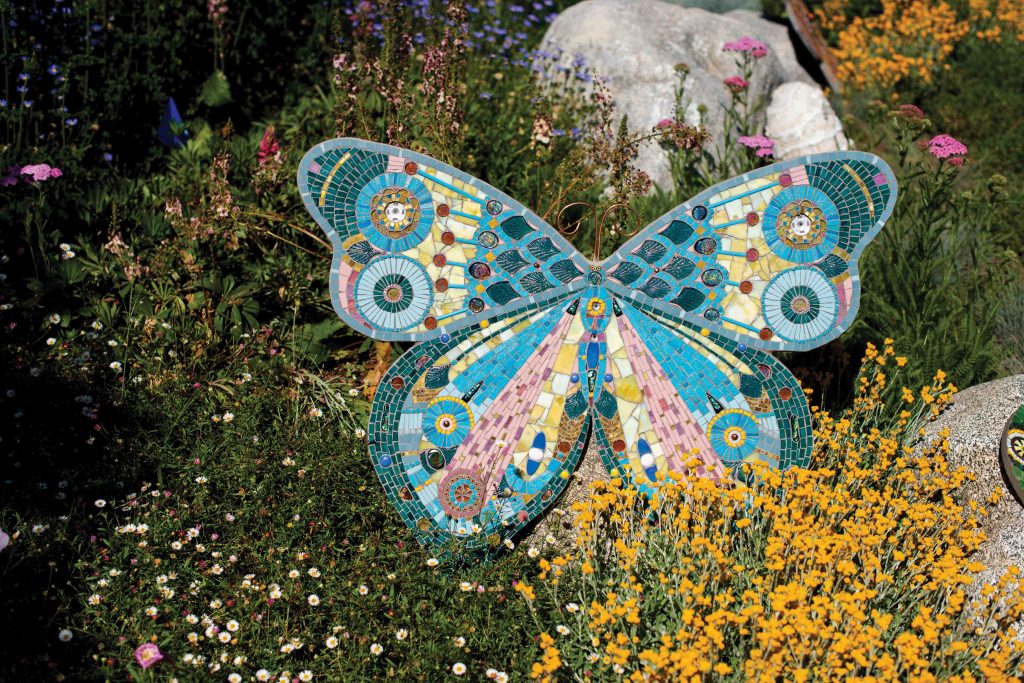
This post was originally published on this site
How did you start working in this medium?
I didn’t get there by degrees. I have a bachelor’s in math and a master’s in library science, but I’ve always been interested in art, and I was always making things. In the ’90s, we were living in Pasadena and after an earthquake, our fireplace was damaged. I had seen pictures in a magazine where someone had decorated their fireplace with broken tile; I said, “I could do that.” And I did. I used broken tile because I didn’t know how to cut tile. I would break it with a hammer or drop it in the driveway. This was pre-internet so I eventually went to the library and read books about mosaics; little by little I decided to see if I could try and make it as a professional artist. I’m 60 years old, and I’m still trying!

Were you artistic as a child?
I grew up in Russia, or rather the Soviet Union. I left when I was 12, and I haven’t been back; so I guess technically I’ve never been to Russia. Even as a kid, you learned not to say things you weren’t supposed to say. Not to repeat anything your parents said. You were always somehow careful. Once I came here, I realized how drab it had been. I was always very attracted to things that were colorful. Everything there was all gray and brown. We lived in cities, so there wasn’t a lot of nature and even the trees managed to be dusty and gray. It was limiting in its way. But I would always draw and make things out of whatever materials I could find. It wasn’t like you could go to the store and buy tons of materials. I used found objects, stuff from the streets and the playground. I would make clothes for my dolls. I would make paper dolls and paper cities. Because we had so few things, we were forced to be much more creative.

What’s your process like?
Like any kind of artwork, I have an idea and sometimes I’ll make it the next week, sometimes I’ll carry around the idea for months or years, marinating in my head. Once I’m actually ready to make it, I do some sketching and see what it looks like outside of my head. On a basic rectangular board, I’ll sketch it and get a general layout. I’ll start cutting glass and attach it to the backing. It sometimes takes its own direction once I start. Sometimes materials suggest something, or it just takes a turn and goes somewhere I wasn’t expecting.
How long does it take to complete a piece?
Depends on the size and complexity. A few days for something small, or months for a bigger piece. My studio is in my garage, so I’ve taken over half the garage at least with shelves and tables and things. I have a small kiln I use to make fused glass pieces for the mosaics. Glass melts at 1500 degrees Fahrenheit, so you can layer special colored glass and it will melt together. I’ll usually make faces or houses or butterflies or flowers to include in the mosaic. So they’re like tiny little mosaics that are fused together and layered. And those go into the big mosaic.
Does that also add texture to the piece?
It can. Most of my mosaics have some sort of element of texture. Different heights and feels. I like setting something smooth like glass or mirror next to something rough like stone.
Some of your pieces even have iPhones embedded into them. What gave you the idea for that?
I did a series of pieces that used computer chips, and I would combine them with something floral so that it’s kind of technology versus nature. There’s always the tension because on the one hand, I love technology. Thanks to the internet, I can look at mosaics from all over the world. On the other hand, I absolutely hate technology because it’s soul-killing at times. When my family convinced me to join the 21st century and get an iPhone, I had the idea. Adam and Eve are reaching for the apple, but it’s an Apple iPhone. They’re taking the first selfie.

Do you also do art installations?
I did a wall at the CHOC floor at Mission Hospital in Mission Viejo, and I’ve done a few at other children’s hospitals such as in Santa Barbara, where I did a childlike view of the pier with colorful boats and buildings.
What kind of pieces can we expect to see at Sherman Library & Gardens?
They have 30-some-odd pieces, mostly with some connection to nature or things that would look nice in a natural setting. A lot of flowers and butterflies, including one very large butterfly, which will be installed in such a way so that people can stand in front of it and take pictures with the wings behind them. That one has about a 6-foot wingspan.
You’ve made a lot of butterflies over the years. Why are they special to you?
Butterflies have somehow always been popping up somewhere in whatever medium I’ve worked in. This is just the perfect medium for butterflies because it’s so colorful. I even made a fused glass butterfly collection and put them in little frames on my wall. Not only are they beautiful but they provide a lovely symbolism. They can really symbolize anything.

